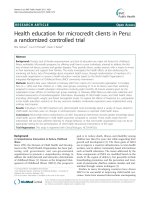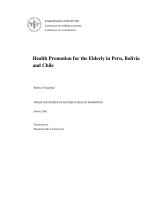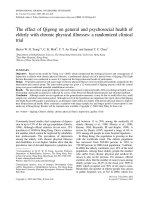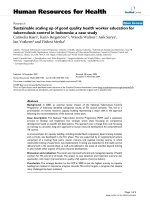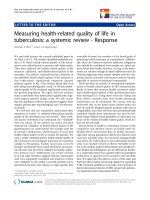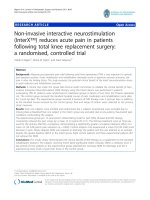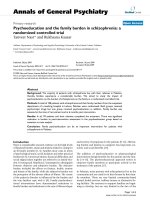Health education for microcredit clients in Peru: a randomized controlled trial potx
Bạn đang xem bản rút gọn của tài liệu. Xem và tải ngay bản đầy đủ của tài liệu tại đây (235.94 KB, 10 trang )
RESEARCH ARTICLE Open Access
Health education for microcredit clients in Peru:
a randomized controlled trial
Rita Hamad
1*
, Lia CH Fernald
2
, Dean S Karlan
3
Abstract
Background: Poverty, lack of female empowerment, and lack of education are major risk factors for childhood
illness worldwide. Microcredit programs, by offering small loans to poor individuals, attempt to address the first
two of these risk factors, poverty and gender disparity. They provide clients, usually women, with a means to invest
in their businesses and support their families. This study investigates the health effects of also addressing the
remaining risk factor, lack of knowledge about important health issues, through randomization of members of a
microcredit organization to receive a health education module based on the World Health Organization’s
Integrated Management of Childhood Illness (IMCI) community intervention.
Methods: Baseline data were collected in February 2007 from clients of a microcredit organization in Pucallpa,
Peru (n = 1,855) and their children (n = 598). Loan groups, consisting of 15 to 20 clients, were then randomly
assigned to receive a health education intervention involving eight monthly 30-minute sessions given by the
organization’s loan officers at monthly loan group meetings. In February 2008, follow-up data were collected, and
included assessments of sociodemographic information, knowledge of child health issues, and child health status
(including child height, weight, and blood hemoglobin levels). To explore the effects of treatment (i.e., participation
in the health education sessions) on the key outcome variables, multivariate regressions were implemented using
ordinary least squares.
Results: Individuals in the IMCI treatment arm demonstrated more knowledge about a variety of issues related to
child health, but there were no changes in anthropometric measures or reported child health status.
Conclusions: Microcredit clients randomized to an IMCI educational intervention showed greater knowledge about
child health, but no differences in child health outcomes compared to controls. These results imply that the
intervention did not have sufficient intensity to change behavior, or that microcredit organizations may not be an
appropriate setting for the administration of child health educational interventions of this type.
Trial Registration: This study is registered with ClinicalTrials.gov, NCT01047033.
Background
A Comprehensive Intervention to Reduce Childhood
Illness
Since 1995, the Division of Child Health and Develop-
ment at the World Health Organization has been part-
nering with governments and non-governmental
organizations to promote a comprehensive strategy to
address the multi-factorial and interactive determinants
of childhood illness [1]. Known as the Integrated Man-
agement of Childhood Illness (IMCI), this program’s
goal is to reduce death, illness, and disability among
children less than five years old, while supporting their
growth and development [2]. The three goals of IMCI
are to improve a country’s infrastructure, to train health
workers, and to deliver community-based inte rventions
such as health education. Theissuesaddressedbythe
three components of IMCI are modified based on the
needs of the region of delivery, but generally include
breastfeeding promotion, and the prevention and treat-
ment of pneumonia, diarrhea, malaria, measles, and mal-
nutrition through various techniques [1].
Studies in many developing countries have shown
IMCI to be successful at improving child health out-
comes. Some have assessed interventions encompassing
* Correspondence:
1
Joint Medical Program, University of California Berkeley - University of
California San Francisco, Berkeley, USA
Full list of author information is available at the end of the article
Hamad et al. BMC Public Health 2011, 11:51
/>© 2011 Hamad et al; licensee BioMed Central Ltd. This is an Open Acc ess article distri buted under t he terms of the Creative C ommons
Attribution License ( which permits unrestricted us e, distribu tion, and reproduction in
any medium, provided the original work is properly cited.
all three IMCI components, while others have assessed
only one or two. A large cluster-randomized controlled
longitudinal trial in rural Bangladesh evaluated a five-
year intervention involving all three components of
IMCI, and included training of health providers, house-
hold visits by trained health workers, and mosque- based
sermons on IMCI-related topics. The study found that
communities receiving IMCI ha d significantly lower
rates of stunting (57% vs. 50%) and higher rates of
exclusive breastfeeding (76% vs. 65%) than those in the
treatment group, in part due to improvements in health-
care provision [3]. An observational study of commu-
nities in Tanzania receiving the health worker training
component of IMCI found more appropriate diagnosis
and treatment of children in health centers compared to
control communities after a treatment period of three
years, as well as increases in health knowledge among
parents [4]. No randomized trials have separated the
independent effects of the community-based educational
component of IMCI.
Integration of Microcredit and Health Education
An early multi-country evaluation of IMCI in Bangla-
desh, Brazil, Peru, Tanzania, and Uganda concluded that
the community component of IMCI should include not
just government health facilities but a broader range of
channels in order to increase the potential reach of
delivery systems [5]. Since then, a diverse group of no n-
governmental organizations (NGOs), including several
microcredit organizations, has begun to incorporate
IMCI-like community interventions into their strategies
for improving child health, either as official partners
with national IMCI programs or on their own [6,7].
Microcredit is an economic intervention involving the
provision of small loans to clients - typically women -
who are too poor to borrow from traditional lending
institutions. Microcredit institutions are diverse, run by
governments, not-for-profit groups, or banks, and oper-
ate throughout the developing world [8]. S ince micro-
credit’ s inception, there has been great interest in the
potential of these small loans to improve the health and
wellbeing of a client’s family and children [9]. Loans are
often given to groups of clients rather than to individual
borrowers, with the assumption that group members
will provide one another with social collateral in place
of physical collateral . Some microcredit organizatio ns
also offer supplemental services to borrowers, such as
education or healthcare, promoting both the social and
economic development of clients [10]. With their wide
distribution and access to poor individuals throughout
the world, microcredit institutions are well positioned to
impl ement educational interventions such as IMCI [11].
Combining IMCI with the economic benefits of micro-
credit may lead to greater improvements in child health
and development outcomes, g iven that poverty is a
major underlying cause of disease in the developing
world.
Several authors have examined the impact of micro-
credit on child health outcomes, although there is little
similarity in the survey or analysis techniques used
across studies. One study in the Dominican Republic
compared three villages - one in which a microcredit
program operated, o ne in which a health promotion
program operated, and another in which both programs
operated - and found that higher rates of childh ood vac-
cination could be attributed to the presence of a micro-
credit program, although there was no difference in
rates of diarrhea or acute respiratory infection [12]. Stu-
dies in Ghana, Bolivia, and Bangladesh that compared
clients receiving microcredit and health education to
comparison groups that received neither intervention
found improvements among the treatment group in a
variety of indicators, such as health knowledge among
parents, feeding frequency and rehydration following a
child’ s diarrheal episode, and child height-for-age
[13-15]. These studies, however, did not distinguish
between the differential effects of the microcredit and
educational components of the intervention.
One observational study conducted in Ecuador and
Honduras compared clients receiving only microcredit
to those receiving microcredit plus health education.
Clients who received an additional health education
component in Honduras had a statistically significant
decrease in childhood diarrhea incidence, whereas there
was no statistically significant difference among bank-
ing-only clients. In Ecuador, banking-only clients experi-
enced a reduction in diarrhea incidence with no
statistically significant difference in incidence among cli-
ents who received an additional health education com-
ponent [16].
Aims and Hypotheses
In this study we used a randomized design to investigate
the eff ects of an IMCI-based hea lth education inter ven-
tion on child health outcomes and parental knowledge
among clients of PRISMA, a microcredit organization in
Pucallpa, Peru. We hypothesized that participation in
health education sessions would improve clients’ knowl-
edge of child health issues, and that this involvement
would translate into healthier development and
decreased illness among children of clients. This study
is novel in investigating the effect of IMCI in the setting
of an economic intervention, in which the potentially
increased income and empowerment provided by the
microcredit may increase clients’ ability to act on the
information gleaned from the educational sessions. Our
sample was diverse with respect to sociodemographic
variables, which allows us to investigate whether
Hamad et al. BMC Public Health 2011, 11:51
/>Page 2 of 10
outcomes differ based on client characteristics. As
female clients have previously been shown to invest
more resources in their children than male clients [17],
we hypothesized that positive effects would be larger
among women and their children. The children of
younger, less educated, or less wealthy parents may also
benefit more from the educational sessions [18].
Methods
Country Context of This Study
This study was conducted in Peru, one of several
countries in Latin America undergoing demographic
and epidemiological transitions. Despite improvements
in the nati on’s healthcare system and infrastructure
and a shift t owards non-communicable diseases, infec-
tious disease remains the leading cause of death [19].
In 2001, 43% of total mortality among children aged
0-4 years was due to communicable diseases such as
respiratory and intestinal infections [20]. A study con-
ducted by Peru’s National Institute of Statistics and
Information T echnology (INEI) in conjunction with
the Demographic and Health Surveys in 2004 found
that 15.1% of children in the preceding two weeks
were reported to have diarrhea, and 17.3% had had
respiratory infections [21].
Study Design and Sampling
This study was carried out from February 2007 to
February 2008 in collaboration with PRISMA, an NGO
that provides microcredit loans to clients throughout
Peru, in addition to other services such as agricultural
development and health education. Our research was
conducted in and around the city of Pucallpa, a city in
the jungle region of eastern Peru. Pucallpa has a popula-
tion of about 136,000, with 93% of residents classified as
urban and 7% as rural [22].
ThePucallpabranchofPRISMAhadatotalof2,134
clients at baseline. Clients organize themselves into loan
groups of 10 to 20 members each. While some groups
consisted entirely of w omen, others included both men
and women. Groups met with a loan officer once a
month at PRISMA’s offices or at the home of a client to
re-pay their loans and participate in other activities as
needed. There were 139 loan groups at baseline, each
overseen and administered by one of four loan officers
hired by PRISMA. At baseline, this branch provided no
services beyond the lending services.
Innovations for Poverty Action, a US-based non-profit
that worked with PRISMA to conduct this study, hired
and trained local Spanish-speaking surveyors. A ques-
tionnaire was developed that included questions on a
variety of indicators, described below, and was translated
into Peruvian Spanish by native speakers fluent in both
English and Spanish. Focus groups took place among a
small group of clients to ensure that questions were
understandable, and validity testing was conducted.
In February 2007, surveyors approached all clients in
Pucallpa after their monthly group meetings to conduct
interviews individually or to schedule an interview at the
client’s home. Surveyors telephoned clients who were
not present in order to schedule an appointment. The
questionnaire, describe d in detail below, was then admi-
nistered. Of the 2,134 clients served by the Pucal lpa
branch, 1,855 consented to complete the survey, for a
response rate of 87.7% (Figure 1). The primary reasons
for non-response included client absence (113 clients)
or refusal (79 clients). Anthropometric measurements
and information about health status were obtained for
598 children under the age of five years.
Process of Randomization
After the baseline survey was completed, half of loan
groups were randomized to receive an additional health
education intervention, described below, in addition to
the existing microcredit services. The remaining loan
groups continued to receive only microcredit s ervices.
Randomization of loan groups was conducted using a
computerized random number generator and implemen-
ted by research assistants based in Peru.
In January and February 2008, surveyors once again
approached clients. Of the 1,855 clients from the base-
line survey, 1,501 (81.0%) consented to participate (Fig-
ure1).Theremainderrefusedtocompletethesurvey
(105 clients), were unable to be located (244 clients), or
Figure 1 Sampling framework.
Hamad et al. BMC Public Health 2011, 11:51
/>Page 3 of 10
had died (3 clients). The NGO’s records indicate that at
least 156 (44.3%) of those clients who refused or could
not be located had dropped out of their loan groups at
some point between the baseline and follow-up surveys.
On the other hand, 432 clients who had dropped out of
their loan groups did complete the follow-up survey,
and among these clients, there was no significant differ-
ence in loan group drop-out rates between those in the
treatment (29.3%) and control (29.4%) groups. Clients
provided information for 454 (75.9%) of the children
that had been evaluated at baseline.
In accordance with the recommendations of the CON-
SORT Group [23], an initiative to promote transparent
reporting of parallel-group randomized controlled trials,
we have completed the standard CONSORT checklist
and flow diagram to provide further details of the imple-
mentation of this study and t he interpretation of its
results (Additional Files 1 and 2).
Ethics Approval
Ethics approval was obtained from the Committee for
the Protection of Human Subjects a t the University of
California Berkeley and the PRISMA and Innovations
for Poverty Action ethics committees. Participants gave
their written consent to take part in the study. Those
with children under the age of five years gave consent
on behalf of their children, and children were also asked
for their verbal assent before being included in the
study. This trial is registered with ClinicalTrials.gov
(NCT01047033).
Description of the Intervention
PRISMA provides microcredit services to urban and
rural individuals and households throughout Peru. It
charges a 4% monthly interest, calculated on the original
balance of the loan, in addition to a 1% commission
when the loan is disbursed. The loan size depends pri-
marily on how long the client has been a member of the
NGO, with the size increasing incrementally with each
loan cycle. The mean loan size among clients in
Pucallpa is US$451 (range: US$106 to US$2468) repaid
over a period of six months. At the end of six months,
most clients continue their relationship with PRISMA
and their loan group to receive additional loans,
although the organization does not keep data to calcu-
late the percentage of clients who drop out.
With the goal of creating a positive social impact on
clients, PRISMA often provides services to microcredit
clients and other community members at its branches,
ranging from support for agricultural development to
education modules on a variety of subjects. The organi-
zation agreed to randomize the IMCI child health edu-
cation module to loan groups in Pucallpa as part of its
commitment to evidence-based practice.
The intervention involved 30 minutes of health educa-
tion, facilitated by loan officers at the end of monthly
group meetings over the course of eight months. As
each loan cycle is six months, the educational sessions
spanned more than one loan cycle, during which clients
remained with their loan group to receive an additional
loan . PRISMA’s US-based affiliate, Freedom From Hun-
ger, developed these sessions based on the community
component of the IMCI strategy developed by the
World Health Organization [2]. During each monthly
meeting, loan officers presented basic information on
child health to clients and provided an opportunity for
the men and women to discuss their own experiences
and identify appropriate solutions. Examples of topics
covered included diarrhea, cough, and fever, as well as
information about interactions with healthcare providers
in order to empower caregivers during clinic visits.
Measures
Treatment Variable
The treatment group was represented by a binary vari-
able corresponding to whether the client’sloangroup
was randomized to receive health education.
Sociodemographic Variables
Clients were asked about their age, gender, and educa-
tional attainment at the time of the baseline study. We
hypothesized that the effects of education and age
would be non-linear, and that an attainment of a mini-
mum threshold of age and educational status would be
more important as a predictor variable than incremen-
tal effects would be. Therefore age and educational sta-
tus were split at the 25
th
percentile to create binary
variables representing clients who were younger than
32 years and clients w ho had not yet completed pri-
mary education, respectively. Clients also provided the
age (in months) and gender for each of their children
below five years of age at the time of the baseline
study. Information was obtained on assets owned by
the household, such as televisions, cars, and refrigera-
tors, usin g questions ada pted from De mographic an d
Health Surveys [24]. As in previous studies, principal
component anal ysis (PCA) was used to const ruct one
variable representing household assets as a proxy for
relative poverty among households [25,26]. As above,
this variable was then split at the 25
th
percentile to
create a binary variable representing clients with fewer
household assets.
Loan Officer Quality
The results of a separate qualitative evaluation, not
shown here, suggested that some of the four loan offi-
cers were more skilled at facilitating the health educa-
tion sessions than others, demonstrating more
knowledge about health topics and a greater ability to
engage the clients d uring the sessions. Based on these
Hamad et al. BMC Public Health 2011, 11:51
/>Page 4 of 10
findings, a binary variable was created to indicate
whether a client’s loan officer was skilled or unskilled.
Outcome Variables
Health Knowledge Clients were asked a series of ques-
tions to assess their knowledge about childhood illness.
For example, they were asked to identify threatening
situations that might lead them to take their child to a
clinic, such as if the child had bloody diarrhea, vomiting,
or difficulty breathing. They were also asked to identify
appropriate treatments for these conditions, such as giv-
ing a child increased fluids for diarrhea. These data
were only collected at follow-up, and the questions were
based on prior surveys conducted by Freedom From
Hunger.
Child Health Status Clients were asked a series of
questions about the health of each of their children
under the age of five years, based on the content of the
intervention. For example, they were asked how many
days of diarrhea the child had experienced in the last
four weeks, or wheth er they had had difficulty breathing
due to a cough. These data were only collected at fol-
low-up. Additionally, height and weight were collected
at baseline and follow-up using standard techniques
[27]. Wooden stadiometers were constructed locally to
measure height, and digital Taylor Electronic Lithium
Scales Model 7324W recorded weight. Z-scores for each
child’s weight-for-age, length/ height-for-age , and body
mass index (BMI)-for-age were calculated using WHO
reference standards [28]. These were then used to deter-
mine the prevalence of underweight, stunting, and over-
weight in this population. Blood hemoglobin levels were
measured at baseline and follow-up with finger pricks
using the HemoCue Hb 201+ System (HemoCue Inc.,
Lake Forest, CA). Hemoglobin levels were not adjusted
for altitude because Pucallpa lies at 200 m above sea
level [29].
Data Analysis
Data were double-entered using CSPro 3.3 (U.S. Census
Bureau, Population Division, Washington, D.C.). Statisti-
cal analyses were conducted using S TATA SE 10.1 for
Windows (STATA Corporation, College Station, TX).
Balance between the treatment and control groups
was tested using t-tests or tests of proportions, as
appropriate. To explore the effects of treatment (i.e.,
particip ation in the health education sessions) on the
key outcome variables, multivariate regressions were
implemented using ordinary least squares. The predictor
variable was a binary variable corresponding to rando-
mization into the treatment or control arm.
Each regression controlled for the sociodemographic
variables listed above. Where possible, we also con-
trolled for the baseline value of the outcome variable.
Standard errors were calculated allowing for clustering
within the loan group, the unit of randomization. Simi-
larly, regressions of child-related outcomes allowed for
standard errors to be clustered at the level of the parent,
as several clients had more than one child that partici-
pated in the survey. Interactions between treatment
group and client age, gender, education, and household
assets were conducted using standard techniques [30].
We also include d an interaction between the t reatment
group and the skill level of the loan officer.
Results
Characteristics of Clients and Their Children
Clients randomized to the two study arms were
balanced with respect to most demographic and socioe-
conomic characteristics at baseline (Table 1). Children
of clients in the treatment and control groups were
balanced with respect to age, gender, and anthropo-
metric measures (Table 2).
Analysis of Effect of IMCI on Child Health
At the one-year follow-up, clients whose loan groups
were randomized to receive the education sessions were
significantly more knowledgeable on a variety of issues
related to child health (Table 3). Analyses of interaction
terms revealed that less educated parents who were ran-
domized to the treatment group demonstrated more
knowledge about doctor’ s office activities than more
educated parents who received treatment. There were
no other significant heterogeneous treatment effects
with respect to client age, gender, or educati on, or child
age and gender (data not shown), although sample size
on subsamples would only detect large differences.
Child anthropometric measures and reported health
status were not significantly different between the two
groups (Table 4). Analyses of interaction terms reveal ed
that the children of clients who recei ved treatment from
a skilled loan officer had reduced bloody diarrhea in
comparison to the children of those who had an
uns killed loan officer. There were no significant hetero-
geneous treatment effects with respect to client age,
gender, or education, or child age and gender (data not
shown), although sample size on subsamples would only
detect large differences.
Discussion
This results of this study indicate that randomization to
a health education intervention based on the WHO’s
IMCI strategy improved health knowledge in a large
sample of microcredit clients in urban Peru on some
issues related to child health. There were no differences
in child anthropometric measures or reported child
health status. Less educated parents demonstrated more
knowledge than more educated parents on one aspect of
child health, and children of clients who received
Hamad et al. BMC Public Health 2011, 11:51
/>Page 5 of 10
treatment from skilled loan officers were less likely to
have bloody diarrhea than those whose loan officers
were unskilled.
Previous evaluations of IMCI have involved assess-
ments of all three program components combined [3],
or assessments of just the health worker training com-
ponent or the community education components in
isolation [32-34]. Of those examining the community
education component, one study in Armenia showed
improvements in both parental knowledge and practice
[35], while studies in Peru, Honduras, and Ethiopia
demonstrated improvements in child health outcomes
as well [36,37].
We propose several explanations why this evaluation
did not alter child health status despite improvements
in parental know ledge. Traditional models of health
promotion suggest that, once individuals gain
increased knowledge about a health concept, they must
then alter their attitudes and behaviors before a change
is seen in the outcome [38]. Our study only measured
changes in client knowledge and health outcomes, and
may have failed to capture whether attitudes and beha-
viors among study subje cts were impacted. It is also
possible that one component of IMCI considered in
isolation was not sufficient t o change behaviors and
outcomes in this population, as the local healthcare
infrastructure remained unchanged and possibly inade-
quate. This suggestion was also made by a previous
study in Brazil that found no changes in child health
indicators after impleme ntation of an isolated IMCI
health worker training intervention [32].
WhileapreviousstudyofacommunityIMCIpro-
gram in Peru found that child health outcomes
improved in the absence of the other IMCI compo-
nents [37], the context of the intervention and the
delivery methods differed significantly from those of
Table 1 Client characteristics at baseline
Variable Study Arm Test of proportions
or t-test
Demographic Characteristics Control
(n = 935)
Treatment
(n = 920)
Gender (%)
Male 14.9 13.2 0.30
Female 85.1 86.8
Age (%)
< 30 years 17.1 18.4 0.47
30-39 years 34.8 34.4 0.87
40-49 years 30.1 29.3 0.71
50-59 years 15.3 15.3 0.97
≥60 years 0.03 0.03 0.93
No. of children < 5 yrs old surveyed (mean ± SD) 0.35 ± 0.59 0.31 ± 0.53 0.12
Socioeconomic Characteristics
Education (%)
Primary or less 26.9 26.1 0.69
Incomplete secondary 24.7 28.4 0.08
Complete secondary 26.4 25.8 0.77
Post-secondary 21.9 19.7 0.24
Household assets, PC
a
(mean ± SD) -0.12 ± 1.6 0.07 ± 1.8 0.02
a
Principal component.
Table 2 Child characteristics at baseline
Variable Study Arm Test of
proportions
or t-test
Demographic
Characteristics
Control
(n =
319)
Treatment
(n = 279)
Gender (%)
Male 47.4 52.3 0.24
Female 52.6 47.7
Age (in years; mean ± SD) 2.6 ± 1.4 2.6 ± 1.4 0.66
Child Anthropometric
Measures
a
Hemoglobin, g/dL 10.9 ±
1.2
10.9 ± 1.3 0.91
Weight-for-age, Z-score -0.60 ±
1.4
-0.73 ± 1.3 0.26
Length/height-for-age, Z-
score
-1.2 ±
1.4
-1.4 ± 1.4 0.09
BMI-for-age, Z-score 0.31 ±
1.4
0.24 ± 1.3 0.61
a
Results are given as mean ± SD.
Hamad et al. BMC Public Health 2011, 11:51
/>Page 6 of 10
this study. The previous study took place among a
community in Peru in which the majority of the resi-
dents are employed in the agricultural industry, a
population that is less educated and less financially
stable than our sample of urban-based microentrepre-
neurs [22]. That evaluation also involved i nteractive
home visits to individual families by local Red Cross
personnel rather than monthly group education ses-
sions by microcredit loan officers. The benefits of tak-
ing advantage of the existing organizational structure
that a group of microcredit clients provides may be
outweighed by a loss of individualized attention to
each parent’ s needs and a decrease in the intensit y of
the intervention.
Also, while loan officers in this study were trained to
carry out the education sessions, they did not have the
extensive health training that a member of the Red
Cross possesses. In informal interviews with the loan
officers at the Pucallpa branch, all expressed frustra-
tion at being requested to educate clients about infor-
mation with which they werenotveryfamiliar,and
without financial compensation for spending the extra
time to do so. In observing several client meetings, the
authors of this study noticed a variation in the quality
of the educational sessions being conducted by the var-
ious loan officers. This finding was confirmed in sec-
ondary analyses (not shown), in which clients of
particular loan officers consistently ranked significantly
lower in knowledge than those of other loan officers.
As described above, we also found that parents whose
loan officers were skilled reported less bloody diarrhea
in their children than those whose loan officers were
less skilled.
Another large study of IMCI in Peru found that child
health indicators did not improve [39]. They noted that,
in contrast to Bangladesh and Tanzania, where prior
studies of IMCI have been successful [3,4], Peru has
lower infant mortality rates and a population with a
relatively higher socioeconomic status. Moreover, clients
in this study demonstrated a higher socioeconomic sta-
tus than the average Peruvian population (data not
shown), with 93% of clients reporting electricity in their
homes compared to 73% nationally, and higher average
educational attainment compared to a national sample
[21]. Consequently, these individuals may not benefit as
much from an interve ntion targeted primarily to poorer
populations [39]. While our study found increased client
knowledge among those in the treatment group, overall
awareness of child health issues was already high. Lack
of knowledge therefore may not be the limiting factor
for child morbidity, or a more sophisticated intervention
may be more appropriate in this setting.
Conclusions
Our study suggests that a child health educational
intervention based on the WHO’ s IMCI strategy was
not an effective method to improve child health out-
comes among microcredit clients in a major urban
center in Peru. Various a spects of the IMCI strategy
have been found to be successful in other settings and
should be pursued; this study, however, joins a few
others in demonstrating that some variations of this
intervention, particularly if they are not intensive, may
not be effective. Moreover, while microcredit is being
proposed worldwide as a powerful economic interven-
tion and as a strong method through which to deliver
Table 3 Caregiver health knowledge at follow-up, by study arm
Control Treatment b-coefficient
(95% CI)
n p-value
a
Caregiver Health Knowledge:
Percent of clients able to report at least one item in each category
Diarrhea danger signs 85.3 90.0 0.12
(0.07, 0.18)
1447 < 0.01
Dietary components for child w/diarrhea 74.3 82.7 0.11
(0.04, 0.17)
1383 < 0.01
Elements of changes in care for child w/diarrhea 89.6 93.3 0.10
(0.03, 0.18)
1472 0.06
Cough danger signs 96.8 96.3 0.05
(-0.01, 0.10)
1467 0.64
Other danger signs 76.2 82.7 0.09
(0.00, 0.17)
1312 0.02
Knowledge of doctor’s office activities 92.9 96.6 0.18
(0.05, 0.31)
1435 < 0.01
Knowledge of important activities after doctor’s appointment 97.2 98.4 0.04
(-0.02, 0.11)
1477 0.07
a
Multivariate analyses clustered at the group level and controlling for client gender, age, and education, household assets, and loan officer.
Hamad et al. BMC Public Health 2011, 11:51
/>Page 7 of 10
other supplemental programs, there are few rando-
mized controlled trials to support these claims and
more studies are needed t o rigorously evaluate whether
microcredit offers a promising platform for delivering
supplemental services.
Additional material
Additional file 1: CONSORT Flow Diagram. As described in the
Methods section, we have included the standard CONSORT checklist and
flow diagram to provide further details of the implementation of this
study and the interpretation of its results.
Additional file 2: CONSORT Checklist. As described in the Methods
section, we have included the standard CONSORT checklist and flow
diagram to provide further details of the implementation of this study
and the interpretatio n of its results.
Funding
The American Women’s Hospitals Services, the Bixby Program at the
University of Californ ia Berkeley (UCB), the Center for Latin American Studies
at UCB, the Dean’s Summer Fellowshi p at the University of California San
Francisco (UCSF), the Human Rights Center at UCB, the Interdisciplinary MPH
Program at the UCB School of Public Health, the Rainer Fund, the UCSF-UCB
Joint Medical Program, and the Bill and Melinda Gates Foundation. Study
Table 4 Child anthropometric measures and health status at follow-up, by study arm
Control Treatment b-coefficient
(95% CI)
n p-value
a
Child Anthropometric Measures
b
Hemoglobin, g/dL 11.5 ± 1.2 11.5 ± 1.1 0.01
(-0.23, 0.26)
312 0.94
Anemia
c
(%) 49.2 48.0 0.02
(-0.08, 0.12)
312 0.70
Weight-for-age, Z-score -0.71 ± 1.1 -0.73 ± 1.0 -0.02
(-0.26, 0.23)
309 0.87
Underweight
d
(%) 10.6 7.7 -0.04
(-0.11, 0.03)
301 0.28
Length/height-for-age, Z-score -1.3 ± 1.3 -1.4 ± 1.6 -0.14
(-0.51, 0.23)
283 0.46
Stunting
e
(%) 24.3 28.4 0.01
(-0.08, 0.11)
264 0.77
BMI-for-age, Z-score 0.13 ± 1.3 0.29 ± 1.4 0.18
(-0.15, 0.51)
290 0.29
Overweight
f
(%) 17.5 25.7 0.05
(-0.05, 0.15)
265 0.31
Reported Child Health Status
g
Diarrhea 15.8 22.3 0.05
(-0.03, 0.13)
439 0.19
Bloody diarrhea 15.3 4.2 -0.11
(-0.24, 0.02)
85 0.09
Days of diarrhea (mean ± SD) 3.6 ± 5.0 2.6 ± 1.6 -1.04
(-2.54, 0.45)
99 0.17
Diarrhea requiring medical attention 38.4 40.8 0.02
(-0.21, 0.25)
86 0.88
Cough in past month 36.7 40.2 0.02
(-0.07, 0.12)
434 0.61
Days of cough (mean ± SD) 5.4 ± 3.6 5.3 ± 3.6 -0.01
(-1.14, 1.13)
175 0.99
Cough causing difficulty breathing 33.7 33.7 -0.01
(-0.16, 0.14)
167 0.90
Cough requiring medical attention 58.4 58.1 0.05
(-0.11, 0.21)
166 0.57
a
Multivariate analyses clustered at the parent level controlling for child age and gender, client gender, age, and education, household assets, and loan officer.
b
Results are given as mean ± SD, unless noted otherwise. These analyses also controlled for the baseline value of the variable in question.
c
A hem oglobin of < 11 g/dL is considered anemic [29].
d
Underweight is a weight-for-age > 2 SD below the WHO reference [28].
e
Stunting is a length-for-age > 2 SD below the WHO reference [28].
f
Overweight is a BMI above the 85
th
percentile for the chil d’s age [31].
g
Results are given as prevalence during past month (%), unless noted otherwise.
Hamad et al. BMC Public Health 2011, 11:51
/>Page 8 of 10
funders had no role in the study design; in collecting, analyzing, or
interpreting the data; in writing the report; or in the decision to submit the
article for publication.
Acknowledgements
The authors are grateful to Silvia Robles, Miguel Almunia, and Tania Alfonso
for their roles in data collection and cleaning, as well as the surveyors,
collaborating organizations, and study subjects for their participation in this
research.
Author details
1
Joint Medical Program, University of California Berkeley - University of
California San Francisco, Berkeley, USA.
2
School of Public Health, University of
California Berkeley, Berkeley, USA.
3
Department of Economics, Yale University,
New Haven, USA.
Authors’ contributions
RH designed the study, traveled to Peru to supervise data collection,
analyzed and interpreted the data, conducted the literature search, and was
the primary author of the manuscript. LCHF designed the study, interprete d
the data, contributed towards the literature search, and helped author the
manuscript. DSK designed the study, traveled to Peru to supervise data
collection, interpreted the data, and helped author the manuscript. All
authors read and approved the final manuscript.
Competing interests
The authors declare that they have no competing interests.
Received: 25 August 2010 Accepted: 24 January 2011
Published: 24 January 2011
References
1. WHO: Improving child health. IMCI: the integrated approach Washington, DC:
World Health Organization; 1997.
2. Integrated Management of Childhood Illness. [ />child_adolescent_health/topics/prevention_care/child/imci/en/index.html].
3. Arifeen S, Hoque D, Akter T, Rahman M, Hoque M, Begum K, Chowdhury E,
Khan R, Blum L, Ahmed S, et al: Effect of the Integrated Man agement of
Childhood Illness strategy on childhood mortality and nutrition in a rural area
in Bangladesh: a cluste r randomised trial. Lancet 2009, 374(9687):393-403.
4. Armstrong Schellenberg J, Bryce J, de Savigny D, Lambrechts T, Mbuya C,
Mgalula L, Wilczynska K: The effect of Integrated Management of
Childhood Illness on observed quality of care of under-fives in rural
Tanzania. Health Policy Plan 2004, 19(1):1-10.
5. Bryce J, Victora CG, Habicht JP, Black RE, Scherpbier RW: Programmatic
pathways to child survival: results of a multi-country evaluation of
Integrated Management of Childhood Illness. Health Policy Plan 2005,
20(Suppl 1):i5-i17.
6. Child Survival Technical Support Project: Reaching Communities for Child
Health and Nutrition: A Framework for Household and Community IMCI.
Calverton, Maryland; 2001.
7. Levinger B, McLeod J: A Wealth of Opportunity: Partnering with CORE
and CORE Group Members. Washington, DC: CORE Group; 2002.
8. Karlan DS, Morduch J: Access to Finance. In Handbook of Development
Economics, 5. Edited by: Rodrick D, Rosenzweig MR. Amsterdan; 2010:.
9. Yunus M: Toward eliminating poverty from the world: Grameen Bank
experience. In Making Progress: Essays in Progress and Public Policy. Edited
by: Anderson CL, Looney JW. Lanham, MD: Le xington Book s;
2002:371-378.
10. Simanowitz A, Walter A: Ensuring impact: reaching the poorest while
building financially self-sufficient institutions, and showing improvement
in the lives of the poorest women and their families. In Pathways Out of
Poverty: Innovations in Microfinance for the Poorest Families. Edited by: Daley-
Harris S. Bloomfield, CT: Kumarian Press, Inc; 2002:.
11. Dunford C: Building better lives: sustainable integration of microfinance
with education in child survival, reproductive health, and HIV/AIDS
prevention for the poorest entrepreneurs. In Pathways Out of Poverty:
Innovations in Microfinance for the Poorest Families. Edited by: Daley-Harris S.
Bloomfield, CT: Kumarian Press, Inc; 2002:.
12. Dohn AL, Chávez A, Dohn MN, Saturria L, Pimentel C: Changes in health
indicators related to health promotion and microcredit programs in the
Dominican Republic. Revista Panamericana de Salud Pública 2004,
15(3):185-193.
13. Hadi A: Promoting health knowledge through micro-credit programmes:
experience of BRAC in Bangladesh. Health Promotion International 2001,
16(3):219-227.
14. MkNelly B, Dunford C: Impact of Credit with Education on Mothers and
Their Young Children’s Nutrition: Lower Pra Rural Bank Credit with
Education Program in Ghana. Davis, CA: Freedom From Hunger; 1998.
15. MkNelly B, Dunford C: Impact of
Credit with Education on
Mothers and
Their Young Children’s Nutrition: CRECER Credit with Education Program
in Bolivia. Davis, CA: Freedom From Hunger; 1999.
16. Smith SC: Village banking and maternal and child health: evidence from
Ecuador and Honduras. World Development 2002, 30(4):707-723.
17. Thomas D: Intra-household resource allocation: an inferential approach.
The Journal of Human Resources 1990, 25(4):635-664.
18. Fernald LC, Gertler P, Neufeld L: 10-year eff ect of Oportunidades,
Mexico’s conditional cash transfer programme, on child growth,
cognition, language, and behaviour: a longitudinal follow-up study.
Lancet 2009, 374(9706):1997-2005.
19. PAHO: Health situation in the Americas: Basic indicators. Washington, D.C
2009.
20. Mathers CD, Lopez AD, Murray CJL: The Burden of Disease and Mortality
by Condition: Data, Methods, and Results for 2001. Global Burden of
Disease and Risk Factors New York: Oxford University Press; 2006, 45-93.
21. INEI/DHS: Encuesta Demográfica y de Salud Familiar 2004. Lima 2005.
22. INEI/DHS: Censos Nacionales 2007: XI de Población y VI de Vivienda.
Lima 2007.
23. Schulz K, Altman D, Moher D, CONSORT Group: CONSORT 2010 Statement:
updated guidelines for reporting parallel group randomised trials. BMC
Medicine 2010, 8(18).
24. Demographic and Health Surveys. [].
25. Filmer D, Pritchett L: Estimating Wealth Effects without Expenditure
Data–or Tears: An Application to Educational Enrollments in States of
India. Policy Research Working Papers No. 1994. Washington, DC: World
Bank; 1998.
26. Zeller M, Houssou N, Alcaraz GV, Schwarze S, Johannsen J: Developing
Poverty Assessment Tools based on Principal Component Analysis:
Results from Bangladesh, Kazakhstan, Uganda, and Peru. International
Association of Agricultural Economists 2006 Annual Meeting. Queensland,
Australia 2006.
27. Habicht JP: Estandarización de métodos epidemiológicos cuantitativos
sobre el terreno [Standardization of quantitative epidemiological
methods in the field] [Article in Spanish]. Bol Oficina Sanit Panam 1974,
76(5):375-384.
28. WHO: Physical status: the use and interpretation of anthropometry.
Report of a WHO expert committee. Technical report series no. 854.
Geneva 1995, 854.
29. WHO: Iron Deficiency Anaemia: Assessment, Prevention, and Control. A
Guide for Programme Managers. Geneva 2001.
30. Aiken L, West S: Multiple regression: Testing and interpreting interactions
London: Sage Publications; 1991.
31. Mei Z, Grummer-Strawn LM, Pietrobelli A, Goulding A, Goran M, Dietz W:
Validity of body mass index compared with other body-composition
screening indexes for the assessment of body fatness in children and
adolescents. Am J Clin Nutr 2002, 75(6):978-985.
32. Amaral J, Leite AJ, Cunha AJ, Victora CG: Impact of IMCI health worker
training on routinely collected child health indicators in Northeast Brazil.
Health
Policy Plan 2005, 20(Suppl 1):i42-i48.
33. Rowe AK, Onikpo F, Lama M, Osterholt DM, Rowe SY, Deming MS: A
multifaceted intervention to improve health worker adherence to
integrated management of childhood illness guidelines in Benin. Am J
Public Health 2009, 99(5):837-846.
34. Santos I, Victora CG, Martines J, Goncalves H, Gigante DP, Valle NJ, Pelto G:
Nutrition counseling increases weight gain among Brazilian children.
J Nutr 2001, 131(11):2866-2873.
35. Thompson M, Harutyunyan TL: Impact of a community-based integrated
management of childhood illnesses (IMCI) programme in Gegharkunik,
Armenia. Health Policy and Planning 2009, 24(2):101-107.
36. Ali M, Asefaw T, Byass P, Beyene H, Pedersen FK: Helping northern
Ethiopian communities reduce childhood mortality: population-based
intervention trial. Bull World Health Organ 2005, 83(1):27-33.
Hamad et al. BMC Public Health 2011, 11:51
/>Page 9 of 10
37. Harkins T, Drasbek C, Arroyo J, McQuestion M: The health benefits of
social mobilization: experiences with community-based Integrated
Management of Childhood Illness in Chao, Peru and San Luis, Honduras.
Promot Educ 2008, 15(2):15-20.
38. Allport G: Attitudes. In A Handbook of Social Psychology. Edited by:
Murchinson C. Worcester, Mass.: Clark University Press; 1935:798-844.
39. Huicho L, Dávila M, Gonzales F, Drasbek C, Bryce J, Victora CG:
Implementation of the Integrated Management of Childhood Illness
strategy in Peru and its association with health indicators: an ecological
analysis. Health Policy and Planning 2005, 20(S1):i32-i41.
Pre-publication history
The pre-publication history for this paper can be accessed here:
/>doi:10.1186/1471-2458-11-51
Cite this article as: Hamad et al.: Health education for microcredit
clients in Peru: a randomized controlled trial. BMC Public Health 2011
11:51.
Submit your next manuscript to BioMed Central
and take full advantage of:
• Convenient online submission
• Thorough peer review
• No space constraints or color figure charges
• Immediate publication on acceptance
• Inclusion in PubMed, CAS, Scopus and Google Scholar
• Research which is freely available for redistribution
Submit your manuscript at
www.biomedcentral.com/submit
Hamad et al. BMC Public Health 2011, 11:51
/>Page 10 of 10

